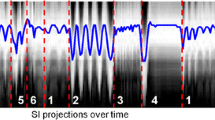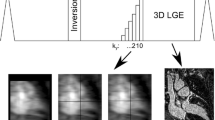Abstract
The aim of the present study was to determine the effects of the latency period on the performance of free-breathing coronary wall MRI. With the approval of IRB, 70 participants were recruited for coronary wall magnetic resonance imaging (MRI) and provided written informed consent. In 35 subjects, right coronary segments (RCA1–3) were imaged first; in the remaining subjects, the left coronary segments (LM and LAD1–3) were imaged first. The images were classified into groups; group 1 contained right coronary images from the subjects whose right coronary segments were imaged first and left coronary images from the subjects whose left coronary segments were imaged first. Group 2 contained the other coronary segments. The image scores (ranked1–3), latency periods, drift of the position of the navigator (NAV), scan efficiency were compared between image groups. Image group 1 has higher scores (1.66 ± 0.55 vs. 1.46 ± 0.51), shorter latency periods (32.04 ± 4.24 vs. 44.22 ± 5.57 min), lower drift in the location of the NAV (1.90 ± 1.27 mm vs. 2.61 ± 1.71 mm) and higher scan efficiency (32.7 ± 7.6 vs. 29.9 ± 7.9 %) than group 2. Long latency periods have a significantly negative impact on the image quality of coronary wall MRI.



Similar content being viewed by others
References
Waxman S, Ishibashi F, Muller JE (2006) Detection and treatment of vulnerable plaques and vulnerable patients: novel approaches to prevention of coronary events. Circulation 114(22):2390–2411
Virmani R, Kolodgie FD, Burke AP, Farb A, Schwartz SM (2000) Lessons from sudden coronary death: a comprehensive morphological classification scheme for atherosclerotic lesions. Arterioscler Thromb Vasc Biol 20(5):1262–1275
Fayad ZA, Fuster V, Fallon JT et al (2000) Noninvasive in vivo human coronary artery lumen and wall imaging using black-blood magnetic resonance imaging. Circulation 102(5):506–510
Botnar RM, Stuber M, Kissinger KV, Kim WY, Spuentrup E, Manning WJ (2000) Noninvasive coronary vessel wall and plaque imaging with magnetic resonance imaging. Circulation 102(21):2582–2587
Lin K, Lloyd-Jones DM, Bi X, Liu Y, Li D, Carr JC (2013) Effects of respiratory motion on coronary wall MR imaging: a quantitative study of older adults. Int J Cardiovasc Imaging 29:1069–1076
Lin K, Bi X, Liu Y et al (2012) Black-blood steady-state free precession (SSFP) coronary wall MRI for cardiac allografts: a feasibility study. J Magn Reson Imaging JMRI 35(5):1210–1215
Lin K, Bi X, Taimen K et al (2012) Coronary wall MR imaging in patients with rapid heart rates: a feasibility study of black-blood steady-state free precession (SSFP). Int J Cardiovasc Imaging 28(3):567–575
Pirzada A, Reid K, Kim D et al (2013) Chicago Healthy Aging Study: objectives and design. Am J Epidemiol 178(4):635–644
Miao C, Chen S, Macedo R et al (2009) Positive remodeling of the coronary arteries detected by magnetic resonance imaging in an asymptomatic population: MESA (Multi-Ethnic Study of Atherosclerosis). J Am Coll Cardiol 53(18):1708–1715
Lin K, Lloyd-Jones DM, Liu Y, Bi X, Li D, Carr JC (2011) Noninvasive evaluation of coronary distensibility in older adults: a feasibility study with MR angiography. Radiology 261(3):771–778
Firbank MJ, Harrison RM, Williams ED, Coulthard A (2000) Quality assurance for MRI: practical experience. Br J Radiol 73(868):376–383
Chen CC, Wan YL, Wai YY, Liu HL (2004) Quality assurance of clinical MRI scanners using ACR MRI phantom: preliminary results. J Digit Imaging 17(4):279–284
Lin K, Lloyd-Jones DM, Liu Y, Bi X, Li D, Carr JC (2012) Potential quantitative magnetic resonance imaging biomarkers of coronary remodeling in older hypertensive patients. Arterioscler Thromb Vasc Biol 32(7):1742–1747
Malayeri AA, Macedo R, Li D et al (2009) Coronary vessel wall evaluation by magnetic resonance imaging in the multi-ethnic study of atherosclerosis: determinants of image quality. J Comput Assist Tomogr 33(1):1–7
Moghari MH, Roujol S, Henningsson M et al (2013) Three-dimensional heart locator for whole-heart coronary magnetic resonance angiography. Magn Reson Med 71:2118–2126
Thorp D, Owens RG, Whitehouse G, Dewey ME (1990) Subjective experiences of magnetic resonance imaging. Clin Radiol 41(4):276–278
MacKenzie R, Sims C, Owens RG, Dixon AK (1995) Patients’ perceptions of magnetic resonance imaging. Clin Radiol 50(3):137–143
Szameitat AJ, Shen S, Sterr A (2009) The functional magnetic resonance imaging (fMRI) procedure as experienced by healthy participants and stroke patients–a pilot study. BMC Med Imaging 9:14
Wollman DE, Beeri MS, Weinberger M, Cheng H, Silverman JM, Prohovnik I (2004) Tolerance of MRI procedures by the oldest old. Magn Reson Imaging 22(9):1299–1304
Versluis MJ, Teeuwisse WM, Kan HE, van Buchem MA, Webb AG, van Osch MJ (2013) Subject tolerance of 7 T MRI examinations. J Magn Reson Imaging 38(3):722–725
Ishida M, Schuster A, Takase S et al (2011) Impact of an abdominal belt on breathing patterns and scan efficiency in whole-heart coronary magnetic resonance angiography: comparison between the UK and Japan. J Cardiovasc Magn Reson 13:71
Acknowledgments
This study was supported by a grant from the National Institute of Health (R01HL089695) and a Grant from the American Heart Association (10CRP3050051).
Conflict of interest
Xiaoming Bi is an employee of Siemens Health care, Chicago, IL. The data and information of this study are under control by authors who are not SIEMENS employee.
Author information
Authors and Affiliations
Corresponding author
Rights and permissions
About this article
Cite this article
Lin, K., Lloyd-Jones, D.M., Liu, Y. et al. The role of latency period in quality management for free-breathing coronary wall MRI. Int J Cardiovasc Imaging 31, 621–627 (2015). https://doi.org/10.1007/s10554-014-0586-6
Received:
Accepted:
Published:
Issue Date:
DOI: https://doi.org/10.1007/s10554-014-0586-6




